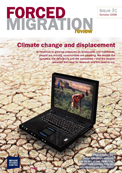(chinadialogue) July 11, 2011 – In December 2008, a series of swells coinciding with seasonal high (“king”) tide engulfed the island atoll of Majuro, capital of the Republic of the Marshall Islands, in the middle of the Pacific Ocean. These waves washed out roads and low-lying houses, forced a state of emergency and caused over US$1.5 million (9.7 million yuan) in damages to an economy totalling US$161 million (1.04 billion yuan).
This was not the first such catastrophe: Majuro has grown used to
battling a major tidal event every decade or so. However, as global carbon emissions continue to increase, sea levels rise and tropical weather events become more numerous and intense, these events will become ever more common. The Marshallese people can respond to such crises every few years, but they cannot respond every few months, and it is possible (indeed probable) that life as they know it will become untenable by the end of the century. This fact raises serious questions about the continued viability of these nations, as well as protections for individuals who may need to relocate.
In late May this year, legal and policy experts from around the world gathered at Columbia Law School to address these and other questions arising from the impacts of global climate change – particularly rising sea levels – on small-island nations.

 UNESCO’s “Migration and Climate Change” brings together the views of 26 leading experts from a range of disciplines such as demography, climatology, economics, geography, anthropology and law. They present case studies from Bangladesh, Brazil, Nepal and the islands of the Pacific, analyzing the often alarming statistics and tearing down the myths associated with one of the most-discussed but least-understood aspects of climate change.
UNESCO’s “Migration and Climate Change” brings together the views of 26 leading experts from a range of disciplines such as demography, climatology, economics, geography, anthropology and law. They present case studies from Bangladesh, Brazil, Nepal and the islands of the Pacific, analyzing the often alarming statistics and tearing down the myths associated with one of the most-discussed but least-understood aspects of climate change.

